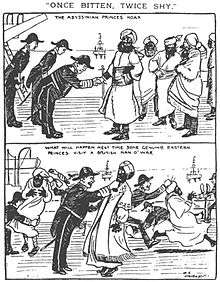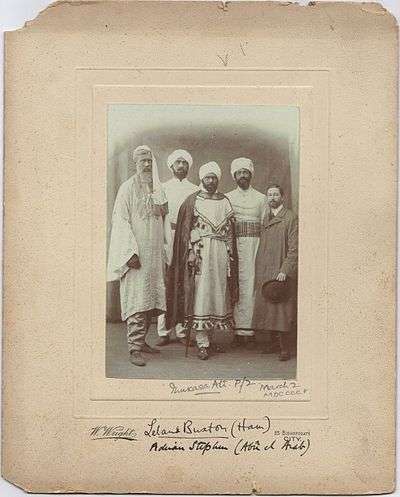Dreadnought hoax

The Dreadnought hoax was a practical joke pulled by Horace de Vere Cole in 1910. Cole tricked the Royal Navy into showing their flagship, the battleship HMS Dreadnought, to a fake delegation of Abyssinian royals. The hoax drew attention in Britain to the emergence of the Bloomsbury Group, among whom some of Cole's collaborators numbered. The hoax was a repeat of a similar impersonation which Cole and Adrian Stephen had organised while they were students at Cambridge in 1905.
Zanzibar hoax at Cambridge
"Prince Musaka Ali and his suite" were in fact students (L-R) Adrian Stephen, Robert Bowen Colthurst, Horace Cole, Leland Buxton and 'Drummer' Howard. In this guise, they hoaxed the Mayor and citizens of Cambridge.
Cole and Adrian Stephen sought diversion while they were students at Cambridge. After a series of minor hoaxes, they decided to do something more elaborate. Stephen wanted to take command of a platoon of German soldiers and lead them across the French frontier to cause an incident. Cole's idea was more feasible—to pose as the Sultan of Zanzibar and make a state visit to Cambridge.
The Sultan was visiting England at the time and details had been published in the newspapers. A telegram was sent to the Mayor, ostensibly from a government official. Cole, Stephen and three other friends then dressed up in robes and turbans and arrived at the railway station where they were met by the Town Clerk who took them to an official reception by the Mayor at the Guildhall. After the reception, charity bazaar and tour of the sights, they were taken back to the station, where they made their escape. The story was then given to the Daily Mail by Cole and became famous. The Mayor wanted the student sent down but was persuaded by the Vice-Chancellor that this would damage his reputation further.[1][2]
Abyssinian hoax on the Dreadnought
The Dreadnought hoax was a similar impersonation which was suggested to Cole by a friend who was an officer on HMS Hawke to hoax their rivals on HMS Dreadnought, including Commander Willie Fisher—the Stephens' cousin—who was on the staff of the Admiral.[3] As Virginia Woolf later recounted,[4]
In those days the young officers had a gay time. They were always up to some lark; and one of their chief occupations it seemed was to play jokes on each other. There were a great many rivalries and intrigues in the navy. The officers like scoring off each other. And the officers of the Hawke and the Dreadnought had a feud. ... And Cole's friend who was on the Hawke had come to Cole, and said to him, 'You're a great hand at hoaxing people; couldn't you do something to pull the leg of the Dreadnought?'
This involved Cole and five friends—writer Virginia Stephen (later Virginia Woolf), her brother Adrian Stephen, Guy Ridley, Anthony Buxton and artist Duncan Grant—who had themselves disguised by the theatrical costumier Willy Clarkson[5] with skin darkeners and turbans to resemble members of the Abyssinian royal family. The main limitation of the disguises was that the "royals" could not eat anything or their make-up would be ruined. Adrian Stephen took the role of "interpreter".
On 7 February 1910 the hoax was set in motion. Cole organised for an accomplice to send a telegram to HMS Dreadnought which was then moored in Portland Harbour, Dorset. The message said that the ship must be prepared for the visit of a group of princes from Abyssinia and was purportedly signed by Foreign Office Under-secretary Sir Charles Hardinge.
Cole with his entourage went to London's Paddington station where Cole claimed that he was "Herbert Cholmondeley" of the Foreign Office and demanded a special train to Weymouth; the stationmaster arranged a VIP coach.
In Weymouth, the navy welcomed the princes with an honour guard. An Abyssinian flag was not found, so the navy proceeded to use that of Zanzibar and to play Zanzibar's national anthem.
The group inspected the fleet. To show their appreciation, they communicated in a gibberish of words drawn from Latin and Greek; they asked for prayer mats and attempted to bestow fake military honours on some of the officers. Commander Fisher failed to recognise either of his cousins.[6]
When the prank was uncovered in London, the ringleader Horace de Vere Cole contacted the press and sent a photo of the "princes" to the Daily Mirror. The group's pacifist views were considered a source of embarrassment, and the Royal Navy briefly became an object of ridicule. The Navy later demanded that Cole be arrested. However, Cole and his compatriots had not broken any law.
Aftermath
During the visit to Dreadnought, the visitors had repeatedly shown amazement or appreciation by exclaiming "Bunga Bunga!".[7] In 1915 during the First World War, HMS Dreadnought rammed and sank a German submarine—the only battleship ever to do so. Among the telegrams of congratulation was one that read "BUNGA BUNGA".[8]
Contemporary media coverage
-

Daily Mirror cartoon, February 1910
-

Report dated London 18 February 1910, published in the Hobart Mercury, Tasmania, 24 March 1910
-

Report in the Evening Post, Wellington, New Zealand, 15 April 1910
-

Royal Navy officers are reported as taking revenge, in the Singapore Free Press and Mercantile Advertiser, 12 May 1910
References
- ↑ Stephen 1983, pp. 20–29.
- ↑ "Hoaxing the Mayor of Cambridge", The Register, Adelaide: Yowieocalypse, p. 3, 10 April 1905
- ↑ Stephen 1983, pp. 29–31.
- ↑ Johnston, Georgia (2009), "Virginia Woolf's Talk on the Dreadnought Hoax", Woolf Studies Annual, 15: 12
- ↑ "The Art of Disguise", Strand Magazine, Archive, 1910.
- ↑ Alberge, Dalya (5 February 2012), "How a bearded Virginia Woolf and her band of 'jolly savages' hoaxed the navy", The Observer
- ↑ Westcott, Kathryn (5 February 2011). "At last – an explanation for 'bunga bunga'". News. BBC.
- ↑ Broome, Jack (1973), Make Another Signal, William Kimber, ISBN 0-7183-0193-5.
Sources
- Stephen, Adrian (October 1983) [1936, Hogarth Press]. The "Dreadnought" Hoax (reprint). London: Chatto & Windus. ISBN 978-0-7011-2747-3. LCCN 83186536.
Further reading
- Downer, Martyn (April 2010). The Sultan of Zanzibar: The Bizarre World and Spectacular Hoaxes of Horace de Vere Cole. London: Black Spring Press. ISBN 978-0-948238-43-7.
- Woolf, Virginia (October 2008). "Dreadnought Hoax Talk". In Rosenbaum, Stanford Patrick. The Platform of Time: Memoirs of Family and Friends (expanded ed.). Hesperus Press. pp. 154–63, 182–202. ISBN 978-1-84391-711-3.
External links
- Dreadnought hoax; Museum of Hoaxes
- "A Woolf in sheikh's clothing": Harvard's Modern Books and Manuscripts Blog
